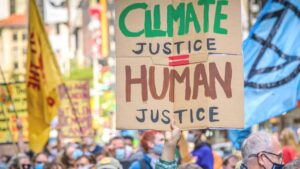Most of the environmental crises we are experiencing today, including climate change, are no secret. Politics aside, I feel confident in saying that nearly everyone has noticed the inconsistent weather patterns, increase in plastic pollution in the oceans, and overall warming temperatures. Maybe biodiversity loss and the increase of GHG emissions in the atmosphere are less realized. The presence of humans on the planet has undoubtedly contributed to these planetary changes. Some nations, however, are at greater fault than others and yet suffer less  of the immediate consequences. It is this disparity that is explained in the extremely powerful article “The Great Acceleration and the Great Divergence” by Rob Nixon.
of the immediate consequences. It is this disparity that is explained in the extremely powerful article “The Great Acceleration and the Great Divergence” by Rob Nixon.
The “Great Acceleration” refers to climate change and the need for immediate action to change our traditional wasteful, unsustainable, and GHG emitting habits. The “Great Divergence” refers to the ever-increasing gap between the wealthy white individuals of industrialized nations and poorer individuals of marginalized communities. Rob Nixon identifies the “central problem with the dominant mode of Anthropocene storytelling [as] its failure to articulate the great acceleration to the great divergence” [1]. That is, we fail to identify how interconnected these two issues are. Mass media often highlights the issues that are facing the public but rarely shows the struggles being faced by those at the front lines. People’s livelihoods are collapsing all around us as the ocean engulfs Pacific Islanders’ homes, Arctic communities melt away, and arid lands dry out and burn up. Many of the individuals with the social location to play a crucial role in political, economic, environmental, and social contexts, are not living the lives of those suffering the most. How can anyone assume the needs of individuals from across the world without, at the very least, hearing firsthand what the communities need to adapt to the detrimental impacts of the Anthropocene’s numerous environmental crises? Therefore, it is so vital to seek out and centralize the most vulnerable and marginalized communities to have any hope at equitably implementing sustainable change.
A great example of the powerful impacts of storytelling can be found with the seemingly simple number, 3.8. In biomimicry’s eyes, this number provides a sense of hope. The earth has been around for 3.8 billion years. We have billions of years of natural resources and systems to learn from. All the information we need surrounds us. I recently found this number again but in a less joyful context. An article by the Washington Post identifies “5 takeaways from the latest United Nations climate change report”, a 3,500-page document released in February 2022. All five points are significant and listed below, but for the context of this post I will focus on #3: “climate change is battering the places and populations least able to adapt, and that is all but certain to continue” [2]. This reinforces Rob Nixon’s point from 2014 that we are facing a great acceleration AND a great divergence that act as catalysts for one another. Many dreadful statistics support this claim including: [2]
- Deaths from floods, droughts, and storms are 15 times higher in highly vulnerable places than low vulnerable places (like many industrialized nations).
- Seal level rise will likely inundate the coastlines where 90% of all Pacific Islanders live.
- African nations have contributed less than 3% of cumulative global emissions yet are projected to experience over ½ of the excess deaths from climate-related illnesses.
Even with these facts and the clear disparities Africans face, industrialized nations with disposition and moral obligation to help, fail to provide effective support. “This disparity extends to basic information needed for adaptation; just 3.8 percent of funding for climate research has gone to projects focused on Africa over the past three decades.” [2] Here we see that 3.8 identifies what little research has been done in the regions that need it the most. This story is significant because we are at a crucial turning point. Our climate and environment are changing, and with it, we must also.
We have plenty of information illuminating the interconnections between this epoch’s environmental and social crises. We know that biomimicry and the 3.8 billion years of nature’s R&D can provide promising and efficient solutions. We also know that there is foundational research lacking in nations most vulnerable to climate change. As Rob Nixon declares, “It is time to remold the Anthropocene as a shared story about unshared resources. When we examine the geology of the human, let us also pay attention to the geopolitics of the new stratigraphy’s layered assumptions.” [1] Let us tell an honest story.
that biomimicry and the 3.8 billion years of nature’s R&D can provide promising and efficient solutions. We also know that there is foundational research lacking in nations most vulnerable to climate change. As Rob Nixon declares, “It is time to remold the Anthropocene as a shared story about unshared resources. When we examine the geology of the human, let us also pay attention to the geopolitics of the new stratigraphy’s layered assumptions.” [1] Let us tell an honest story.
Washington Post’s key takeaways from the 2022 UNCC Report: [2]
- A certain amount of suffering is inevitable, though adaptation can help
- Every incremental increase in temperature will lead to dramatically more disease, death, and frequent, costly disasters
- Climate change is battering the places and populations least able to adapt, and that is all but certain to continue
- Global warming is wreaking havoc on plants and wildlife
- For many locations on Earth, the capacity for adaptation is already significantly limited, even as it becomes more critical
References:
- “The Great Acceleration and the Great Divergence” by Rob Nixon: profession.mla.org/the-great-acceleration-and-the-great-divergence-vulnerability-in-the-anthropocene/
- “5 Takeaways from the Latest UN Climate Change Report” (2022) by Brady Dennis and Sarah Kaplan: